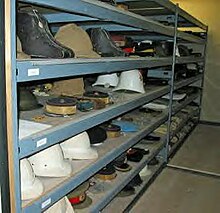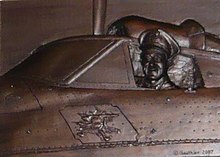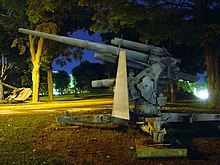 | |
| Established | 1962 |
|---|---|
| Location | Fort Frederick 4 Passchendale Dr. on the campus of the Royal Military College of Canada Kingston, Ontario Ontario East |
| Coordinates | 44°13′40″N 76°28′11″W / 44.2277°N 76.4696°W / 44.2277; -76.4696 |
| Type | military history |
| Curator | Ross McKenzie |
| Website | |
The Royal Military College of Canada Museum, established in 1962, is located in a Martello tower known as Fort Frederick on the campus of the Royal Military College of Canada (RRMC or RMC) in Kingston, Ontario, and is operated by the college. Until 2016 the museum had regular hours from the last weekend in June until Labour Day. Although admission was free, donations were accepted. Guided tours were offered in English and French. Genealogical research and archival records services were offered relating to college history or with inquires relating to ex-cadets when permitted by privacy regulations.
In 2016, restoration work began on Fort Frederick and the Museum moved out of the Tower, leaving the Museum without a designated public exhibition space.
The museum and historic site can also be visited via the Virtual Museum. The Martello tower housing the museum is a 1790 fortification consisting mostly of earthworks with a north wall of stone masonry. It is on the Registry of Historic Places of Canada. Fort Frederick is one of four Martello Towers, built by Corps of Royal Engineers between 1846 and 1848 to augment the Kingston defences. The Martello tower was named in honour of Frederick, Prince of Wales.
Purpose
The museum's purpose is to collect, conserve, research and display artifacts and records relating to the history of the RMCC, achievements of its graduates and the earlier naval history of its site, including the Kingston Royal Naval Dockyard which once occupied Point Frederick.
Collections


The museum also holds a small collection of material related to the Point Frederick dockyard and the Royal Navy.
The Royal Military College and other military units started to collect artifacts in a piecemeal way after the Great War. The college’s commandants indicated in 1918 that he wanted to establish a museum at RMC. Individual requests were made to the War Trophy Commission 1918–19 and artifacts were received over a period of time 1920-26. Major-General Sir Archibald Macdonell, who wished to establish a museum in 1919, wrote a letter to the Secretary of the Militia Council requesting, “that some of the various War Trophies captired by the Canadian Corps may be dispatched to the Royal Military College, for disposal about the grounds and buildings. Oweing to the record of the ex-cadets, it would be only fitting and right that the College be allowed certain trophies.” He noted that some trophies had been turned in from the field to the War Trophies Commission addressed to RMC, but had not yet been received. Major Gustave Lanctôt of the Dominion Archives replied in 1920 that the War Trophies Commission was waiting for governmental policy with respect to the distribution of War Trophies; “may be assured to receive the best treatment possible in view of the fine record of its students and the importance of its standing as a National Military College.”
In September 1922, an army board met at RMC to look at the possibility of creating a museum in Fort Frederick. In January 1926, the Quartermaster General wrote the RMC commandant: “It is the desire of National Defence Headquarters to make the museum at the Royal Military College the principal storehouse for military relics of all natures...” In February 1926, a 12 page inventory of RMC’s holdings included hundreds of small arms, bayonets, scabbards, swords, lances, pistols, machine guns, grenades and bombs, clothing, trench stores, artillery ammunition, engineering models, and other miscellaneous articles. Many of these holdings were of the 1914-1918 vintage, and, many had been captured from the Germans, particularly during 1918.
Between 1922 and 1946, the RMC collections consisted merely of arms and military artifacts collections raised, built and maintained by individuals or very small groups of veterans. Although these items were interesting, there was no overall, coordinated story.
Lady Lee widow of Arthur Lee, 1st Viscount Lee of Fareham presented to the Royal Military College of Canada Museum in 1947 a silver-headed walking stick of her late-husband: which he used daily at RMC fifty-four years earlier. The stick has two silver bands listing the places where Lee served -or visited from 1888 to 1904, which, includes Royal Military College of Canada. Lady Lee also presented the RMC Museum three photographs of Lord Lee - two of them taken in Kingston, one in uniform in 1893, and the other in 1896 wearing a checked suit, silver-topped stick in hand. The third is a photograph of the portrait by James Gunn in full regalia of a Knight Grand Cross of the Most Honourable Order of the Bath.
The museum displays collections of military memorabilia and 7000 items, including a collection of 16th through 20th century arms, uniforms, flags, military art and trophies. It holds, for example, the Douglas Arms Collection which was presented to RMC by Walter Douglas (RMC 1890). The Douglas Arms Collection contains over 400 guns that were originally in the ownership of Mexican President, General Porfirio Diaz. Another significant collection is the Leinster Plate, a collection of silverware, of the Prince of Wales's Leinster Regiment. The Nanton Arms collection was presented to RMC by No 78 Colborne J. Nanton (RMC 1882). The Nanton Arms Collection contains Indian daggers and various other arms that were originally presented by the Maharajah of Cooch Behar to Nanton during his service in India prior to the First World War. A model of the 112-gun HMS St Lawrence (1814) was donated in 2008. The lower floor of the Martello tower contains exhibits on the War of 1812 and the fort’s dockyard. The main floor contains exhibits on the history of the college, and personal mementos of the Old Eighteen, the first class that enrolled in 1876. A gun platform displays the original cannons at the top of the tower. The archives includes cartographic materials, prints and drawings, manuscripts and photographs. The human history consists of manuscripts, medals, military history and technology and weapons.
The museum is also responsible for a collection of Canadian landscape and military art, including paintings, sculpture, and stained glass windows on display throughout the college, though primarily in Currie Hall and Yeo Hall. The college announced in 2011 the establishment of an art venue in the New Learning Center.
Art collection

In 2010, Royal Military College of Canada Museum became responsible for the college’s art collection. The college's art collection consists of just over 1,000 two-dimensional works of art, such as paintings, limited edition prints, drawing]s and other works on paper. The three-dimensional works in the collection include sculptures and stained glass. Approximately 20% of the catalogued art collection at RMCC is on display at the college and the remaining 80% is in storage in Fort Haldimand.
There are works in the art collection by: Admiral Henry Wolsey Bayfield (1795–1885), Christopher Clark, Charles Comfort, Forshaw Day, Jean Redpath Drummond (c. 1845 – c. 1920), Washington F. Friend (c. 1820 – 1886), Thomas Hilton Garside, Lawren Philip Harris, Edward John Hughes, Robert Stewart Hyndman, C.W. Jefferys, Manly MacDonald, Orlando Norie, Thomas Rowlandson, Richard Simkin, William Thurston Topham (1888–1966) and Emeric Essex Vidal (1791–1861).
The works may have been presented to the college by ex-cadets or by graduating classes on the occasion of reunions, as memorials, as commissions or purchases. The Gauthier Collection, gifted by the Class of 1974, consists of 60 military sculptures and bas reliefs by Col (Ret’d) André Gauthier, OMM, CD., including one of a Royal Military College of Canada Cadet. A watercolour of ex-cadet #444 Major-General William Bethune Lindsay, CB, CMG, DSO by Canadian artist Richard George Mathews (1870–1955), for example, was donated by ex-cadet, #10263 Don Lovell, in 1981. A landscape painting of a lumber camp in early spring by Manly Edward MacDonald (1889–1971), for example was presented by Dr. Clarence C Cook (#H6890) in 1968 on the occasion of the Class of 1918's 50th anniversary. A posthumous 3/4 length portrait of No. 1557 Colonel William Reginald Sawyer, Director of Studies 1948–1967 standing in front of the Mackenzie Building and the Stone Frigate in his academic robes was commissioned by Charles Fraser Comfort (1900–1994). Mr. John Spurr, the former RMC librarian, acquired items addressing military and political events in late 18th and early 19th century North America, limited edition maps and prints of key battles, caricatures by Thomas Rowlandson, political cartoons, and illustrations of uniforms. Mr. John Spurr acquired watercolour paintings depicting Siege of Ciudad Rodrigo (1812) Jan. 19th 1812, by Richard Simkin (1840–1926); the Battle of Fuentes de Oñoro 5 May 1811, by Orlando Norie (1832–1901); and the ruins of Ypres Cathedral with Canadian troops in the foreground, Nov. 1917 by Christopher Clark (1875–1942). Two panoramic watercolours c 1815 depict Point Frederick and Kingston Harbour and Sackett’s Harbour in New York by Emeric Essex Vidal.
Memberships and affiliations
The museum is a member of the Canadian Museums Association and the Organization of Military Museums of Canada Inc. It is also accredited within the Canadian Forces Museum System. It is affiliated with the Canadian Heritage Information Network, and the Virtual Museum of Canada. A cooperating association of friends of the museum has been formed to assist with projects. The Parks Canada Agency often participates in joint programs, or provides supporting resources to the Royal Military College of Canada Museum, which is a partner organization.
| Year | Significance |
|---|---|
| 1918 |
|
| 1920 |
|
| September 1922 |
|
| January 1926 |
|
| February 1926 |
|
| 1938 |
|
| 1946 |
|
| July 1946 |
|
| 1957 |
|
| 1960 |
|
| 25 June 1962 |
|
| 2007 |
|- |
| 2010 |
|
War trophies
The Royal Military College of Canada Museum curator oversees the trophies and memorials on the college grounds.





| Artillery or Ordnance | Description | Location |
|---|---|---|
| Blomefield SBML 32-pounder Gun, | weight 57-0-2, (6,386 lbs), Carron, 1806, King George III cypher, | Fort Frederick Tower 3 North. |
| Blomefield SBML 32-pounder Gun, | weight 56-3-0, (6,084 lbs), Carron, 1807, King George III cypher, | Fort Frederick Tower 3 East. |
| Blomefield SBML 32-pounder Gun, | weight 56-0-25, (6,025 lbs), Carron, 1811, King George III cypher, | Fort Frederick Tower 3 West. |
| Blomefield SBML 32-pounder Gun, | Walker Co, King George III cypher, | Parade Square North East. |
| Millar SBML 32-pounder Gun, | weight 64-2-10 (7,234 lbs), Walker Co, 1842, King George III cypher, | Fort Frederick 2. |
| Blomefield SBML 32-pounder Gun, | weight 67-0-9 (7,513 lbs), Carron, 1807, King George III cypher, | Fort Frederick 3. |
| Blomefield SBML 32-pounder Gun, | weight 53-0-25 (5,961 lbs), Walker Co, King George III cypher, | Fort Frederick 5. |
| Blomefield SBML 32-pounder Gun, | weight 64-3-0 (7,252 lbs), Walker Co, 1842, | Fort Frederick 6. |
| Blomefield Palliser conversion of a SBML to RML 32-pounder Gun, | RGF, 1870, Queen Victoria cypher, | Paint Yard. |
| Blomefield Palliser conversion of a SBML to RML 32-pounder Gun, | Queen Victoria cypher, | Paint Yard. |
| Blomefield SBML 32-pounder Gun, | Walker Co, King George III cypher, | Crerar Gateway West. |
| Blomefield SBML 32-pounder Gun, | weight 50-1-14 (5,670 lbs), Walker Co, King George III cypher, | Crerar Gateway East. |
| Blomefield SBML 32-pounder Gun, | Carron, 1807, King George III cypher, | Fort Haldiman. |
| Blomefield SBML 32-pounder Gun, | King George III cypher, | MacDonald West. |
| Blomefield SBML 32-pounder Gun, | Walker Co, King George III cypher, | MacDonald East. |
| SBML 24-pounder Gun, | weight 20-0-4 (2,244 lbs, weight of a 6-pounder), 1847, Queen Victoria cypher, | Fort Frederick North East 1, mounted on long wooden carriage. |
| SBML 24-pounder Gun, | weight 20-0-0 (2,240 lbs, weight of a 6-pounder), 1847, Queen Victoria cypher, | Fort Frederick 7, mounted on long wooden carriage. |
| SBML 24-pounder Brass Gun, | weight 12-3-7 (1,435 lbs), 1843, CLXXV (175), Queen Victoria cypher, DEMD, | Senior Staff Mess North. |
| SBML 9-pounder Brass Gun, | weight 13-2-0 (1,512 lbs), FM Eardly-Wilmot, 1859, Queen Victoria cypher, 4862, | Senior Staff Mess South. |
| SBML 9-pounder Brass Gun, | 1813, Dolphin handles, DLVIII (558), King George III cypher, | flagpole East. |
| SBML 9-pounder Brass Gun, | 1812, Dolphin handles, CCCLIV (354), King George III cypher, | flagpole West. |
| SBML 32-pounder Gun, | Carron, weight 17-3-7 (1,995 lbs), | Fort Frederick Tower 2 North West. |
| SBML 32-pounder Gun, | Carron, 1808, | Fort Frederick Tower 2 North. |
| SBML 32-pounder Gun, | Carron, 1804, | Fort Frederick Tower 2 North East. |
| SBML 32-pounder Gun, | Carron, weight 17-3-7 (1,995 lbs), | Fort Frederick Tower, Main South. |
| SBML 32-pounder Gun, | Carron, weight 17-3-11 (1,999 lbs), | Fort Frederick Tower, Main North. |
| SBML 32-pounder Gun, | Carron, weight 17-1-21 (1,953 lbs), | Fort Frederick Tower, Main North East. |
| SBML 10-inch 52-cwt Mortar, | weight 18-x-x (>2,000 lbs), Walker Co, 1856, shot in the muzzle, | Stone Frigate North. |
| SBML 10-inch 52-cwt Mortar, | weight 18-1-9 (2,053 lbs), shot in the muzzle, | Stone Frigate South. |
| Armstrong RBL 7-inch 72 cwt Gun, | weight 81-3-3 (9,159 lbs), 1862, Queen Victoria cypher, | mounted on a long wooden carriage, Fort Frederick 4. |
| Blomefield SBML 12-pounder Gun, | 4.75-inch2 foot long gun fragment, | Fort Frederick Tower B. |
| Blomefield SBML 12-pounder Gun, | 4.75-inch, 2 feet 5 inches long, embedded in the road at a 30-degree angle, | Main Gate North. |
| Blomefield SBML Gun, 4.75-inch, | 2 feet 5 inches long, embedded in the road at a 30-degree angle, | Main Gate South. |
| German Second World War 8.8-cm | 7.5 cm Infanteriegeschütz 37 FlaK 37 Anti-Aircraft Gun, (Serial Nr. R5456) 1042 CXX (120), | Crerar Crescent. |
| German Second World War 8.8-cm Panzerabwehrkanone 43 | (8.8-cm PaK 43) Anti-tank Gun, Breeching Ring (Serial Nr. R1243), | Crerar Crescent. |
| Ordnance QF 25-pounder Gun, | Reg No, 16055, | Massey Library, by the Cadet statue. |
| M109 155-mm Self-propelled Howitzer, | (Reg. No. 77225), 1985, AC: AX, ECC: 119205 HUI C: 1941, SAUI C: 1941, VMO No. DLE29685, VMO Date: 09 Dec 2002. | Training Aid, RMC. |
Memorials
| Other | Description |
|---|---|
|
|
|
|
|
|
|
|
|
|
|
|
|
|
|
|
|
|
See also
References
- "Fort Frederick". Webcitation.org. Archived from the original on 2009-10-26. Retrieved 2011-03-20.
- "Travel guide to museums and galleries in Canada | Virtual Museum of Canada Find a Museum". Virtualmuseum.ca. Retrieved 2013-05-28.
- "Travel guide to museums and galleries in Canada | Virtual Museum of Canada Find a Museum". Virtualmuseum.ca. Retrieved 2011-03-20.
- "Martello Tower Registry of Historic Places of Canada". Historicplaces.ca. Retrieved 2011-03-20.
- "RMCC - Dockyard History - Spy Glass - Museum of the Royal Military College of Canada". Rmc-cmr.ca. 2009-01-08. Retrieved 2011-03-20.
- "Parks Canada - Nomination of the Rideau Canal for Inscription in the World Heritage List - Nomination of the Rideau Canal for Inscription in the World Heritage List". Pc.gc.ca. 2009-04-15. Retrieved 2011-03-20.
- A Brief History Of Canadian Forces Military Museums From 1919 To 2004 by Dr. Serge Bernier
- Lord Lee of Fareham Professor of Strategy and Tactics, R.M.C., 1893-98 By No. 2141, T. L. Brock; Royal Military College of Canada Review yearbook 1962 p 189
- Douglas Arms Collection Retrieved 2013-05-28
- RMC Museum - Leinster Plate Retrieved 2011-10-2
- http://everitas.rmcclub.ca/?cat=5 No 78 Colborne J. Nanton (RMC 1882)
- Kamille Parkinson, PhD 'An Impressive Art Collection at RMCC' (Kingston, E-veritas, June 25, 2012
- Museum of the Royal Military College of Canada
- Canadian Forces Museums "Canadian Forces Museums". Archived from the original on 2008-10-18. Retrieved 2008-10-18.
- "Parks Canada". Pc.gc.ca. 2009-04-15. Retrieved 2011-03-20.
- "Internet Archive: Details: The Stone Frigate, 1914". Retrieved 2011-03-20.
- "Archived copy" (PDF). Archived from the original (PDF) on 2011-09-28. Retrieved 2011-03-20.
{{cite web}}: CS1 maint: archived copy as title (link) - Historical pieces of artillery at RMC
- RMC Memorial windows "Ontario Crafts Council". Archived from the original on 2011-07-06. Retrieved 2009-05-10.
- Brochures
- Royal Military College of Canada, Fort Frederick: Facts brochure, (Kingston, 2000).
- Royal Military College of Canada, Visit Fort Frederick and the Royal Military College of Canada Museum brochure, (Kingston, 2000).
- Books
- George F.G. Stanley, Richard A. Preston (1950). 'A short history of Kingston as a military and naval centre'. Kingston, Ont.
{{cite book}}: CS1 maint: location missing publisher (link)
External links
| Royal Military College of Canada | |
|---|---|
| Centres | |
| Student life | |
| Buildings and features | |
| Other | |
| Canadian Armed Forces | |
|---|---|
| Military history | |
| Leadership | |
| Commands | |
| Academies | |
| Lists | |
| Others | |